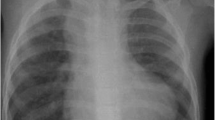Abstract
Congenital heart diseases have varied presentations depending on the age of presentation. Regression of neonatal pulmonary hypertension and the timing of establishment of left to right shunt determines the onset of symptoms. Pre-tricuspid shunts generally remain asymptomatic during the childhood while large post-tricuspid shunts present with heart failure in late neonatal or early infancy period. Admixture lesions have pathophysiology similar to large post tricuspid shunts with additional small right to left shunt causing mild systemic desaturation. Murmurs are prominent in valvular heart diseases. Careful clinical assessment of features of high pulmonary blood flow, presence of absence of systemic desaturation, status of second heart sound and murmur would help to arrive at a reasonable bedside diagnosis.

Similar content being viewed by others
References
Zulfikar Ahamed M, Sajan Ahmad Z, Abhilash TG. Approach to infants and children with cyanotic congenital heart disease. Kerala Heart J. 2015;5:30–5.
Tandon R. Bedside approach in the diagnosis of congenital heart diseases. New Delhi: Bi publications Pvt ltd. India; 1999.
Somerville W. Bedside diagnosis of congenital heart disease. Postgrad Med J. 1956;32:62–8.
Rao PS. Diagnosis and management of acyanotic heart disease: part II – left to right shunt lesions. Indian J Pediatr. 2005;72:503–12.
Lee JY. Clinical presentations of critical cardiac defects in the newborn: decision making and initial management. Korean J Pediatr. 2010;53:669–79.
Rao PS. Diagnosis and management of acyanotic heart disease: part I – obstructive lesions. Indian J Pediatr. 2005;72:496–502.
Saxena A, Relan J, Agarwal R, et al. Indian guidelines for indications and timing of intervention for common congenital heart diseases: revised and updated consensus statement of the Working Group on Management of Congenital Heart Diseases. Ann Ped Card. 2019;12:254–86.
Author information
Authors and Affiliations
Corresponding author
Ethics declarations
Conflict of Interest
None.
Additional information
Publisher’s Note
Springer Nature remains neutral with regard to jurisdictional claims in published maps and institutional affiliations.
Rights and permissions
About this article
Cite this article
Kannan, B. Clinical Diagnostic Approach to Congenital Acyanotic Congenital Heart Disease in Infants and Children. Indian J Pediatr 87, 381–384 (2020). https://doi.org/10.1007/s12098-020-03251-w
Received:
Accepted:
Published:
Issue Date:
DOI: https://doi.org/10.1007/s12098-020-03251-w




